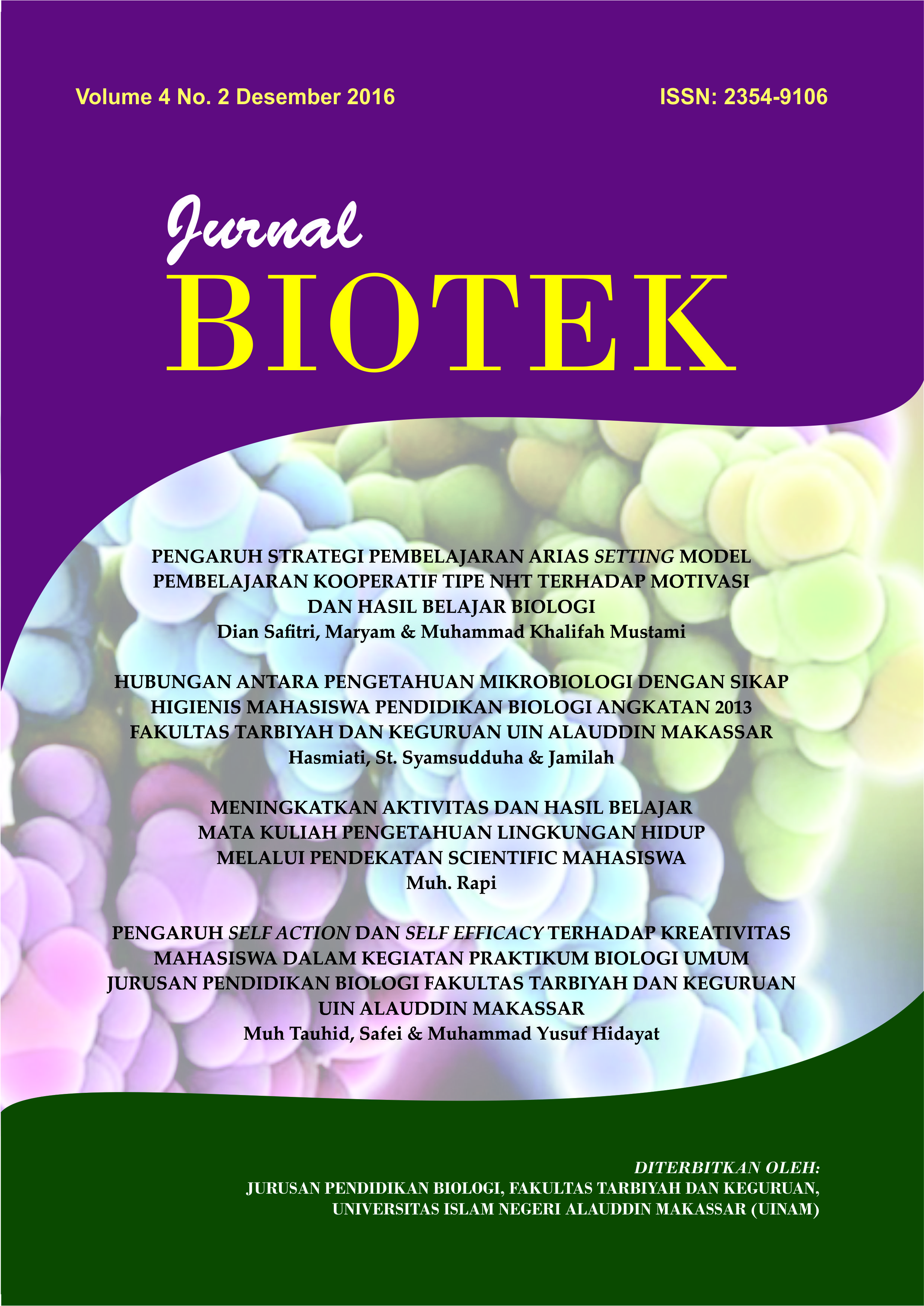PENGARUH SELF ACTION DAN SELF EFFICACY TERHADAP KREATIVITAS MAHASISWA DALAM KEGIATAN PRAKTIKUM BIOLOGI UMUM JURUSAN PENDIDIKAN BIOLOGI FAKULTAS TARBIYAH DAN KEGURUAN UIN ALAUDDIN MAKASSAR
Abstrak
This research is aimed to find out description self action, selfefficacy, and of students’ creativity also to effect of self actionand self efficacy towards the students’ creativity in general biology practical lab.
The population of this research was the all students of Biology Education Department, UIN Alauddin Makassar starting from 2012 generation until 2015 generation that consist 11 classes with amount of 400 students. While the sample have taken by used of Simple Random Samplingtechnique,sothatthis research obtained74 students. The Instrument was used questioner. Data analysis technique was used descriptive statistic and inferential technique.
The results of this research through descriptive analysis obtained mean score for self action was 70,20 in the medium category, mean score of self efficacy was 45,28 in the medium category, and mean score of students’ creativity was 51,93 in the medium category. Inferential statistic analysis results with F tes obtained that score Fcount>Ftable (13,778>3,13). Thus, it can be concluded that there is significant effect between self action and self efficacy towards students’ creativity in general biology practical lab at Biology Education Department of UIN Alauddin Makassar.
##plugins.generic.usageStats.downloads##
Referensi
Alwisol. (2009). Psikologi kepribadian. Malang: UMM press.
Amiruddin, Abul Hak, dan Abadi. (2006). Pendekatan psikologi anak. Yogyakarta: Pustaka Timur.
Ayan, Jordan E. (2003). AHA! 10 Ways to Free Your Creative Spirit and Find Your Great Ideas, terj. Ibnu setiawan, Bengkel Kreativitas: 10 Cara Menemukan Ide-Ide Pamungkas Melalui Pergaulan, Lingkungan, Perjalanan, Permaianan, Bacaan, Seni, Teknologi, Berfikir, Alam Bawah Sadar, Jiwa Kreatif. Bandung: Mirzan Media Utama.
Azwar, Saifuddin. (2014). Penyusunan Skala Psikologi. Cet. VI, Yogyakarta: Pustaka Pelajar.
Baron, Robert A & Donn Byrne. (2003). Psikologi Sosial. Jakarta: Penerbit Erlangga.
Candra, Julius. (1996). Belajar dan Pembelajaran. Jakarta: Dunia Pustaka Jaya.
Craft, Anna. (2004). Creativity Across the Primary Curriculum, terj. M. chairul Annam, Me- Refresh Immajinasi & Kreativitas Anak-Anak. Jakarta: Cerdas Cempaka.
Darmadi. (2011). Metode Penelitian Pendidikan. Bandung; Alfabeta.
Hurlock, Elisabeth (1987). Perkembangan Anak. Jakarta: Erlangga.
Jamaris, Martin. (2013). Orientasi Baru dalam Psikologi Pendidikan. Bandung: Ghalia Indonesia.
Niahidayati. (2016). “Ciri-Ciri Anak Kreatif”, Online, (Diakses di http://niahidayati.net/ciri-ciri-anak-kreatif.html, pada 10 Januari 2016).
Mahiyanto, Bambang & Mahmud Munir. (2003). Kamus Lengkap Inggris-Indonesia, Indonesia- Inggris. Surabaya: Gitamedia Press.
Rahayu, Sri dkk. (2010). Pengembangan Model Pembelajaran Advance Organizer Untuk Meningkatkan Aktivitas dan Hasil Belajar Siswa. Semarang: Jurnal Inovasi Pendidikan Kimia.
Rachmawati, Yeni dan Kurniati, Euis. (2010). Strategi Pengembangan Kreativitas pada Anak Usia Taman Kanak-Kanak, Cet. 1. Jakarta: Kencana.
Safei, Muh. (2012). Telaah Kurikulum Pengajaran Biologi. Makassar: UIN Press.
Santrock, John W. (2007). Perkembangan anak. Jakarta: Erlangga.
Singarimbun, Masri dan Sofian Effendi. (1987). Metode Penelitian Survei. Jakarta: LP3ES.
Sugiyono. (2010). Metode Penelitian Pendidikan Pendekatan Kuantitatif, Kualitatif, dan R&D. Bandung: Alfabeta.
Suryabrata, Sumadi. (1986). Psikologi Kepribadian. Jakarta: Rajawali Pers.
Suryabrata, Sumadi. (2011). Psikologi Pendidikan. Jakarta: Rajawali Pers
Syah, Muhibbin. (2008). Psikologi Belajar. Jakarta: PT Raja Grafindo Persada.
TIM Kurikulum Biologi TBP UNHAS. (2003). Biologi dasar diklat kuliah. Makassar: UNHAS Press.
Authors who publish with Jurnal Biotek agree to the following terms: Authors retain the copyright and grant Universitas Islam Negeri Alauddin Makassar right of first publication with the work simultaneously licensed under a Creative Commons Attribution License (CC BY-SA 4.0) that allows others to share (copy and redistribute the material in any medium or format) and adapt (remix, transform, and build upon the material) the work for any purpose, even commercially with an acknowledgement of the work's authorship and initial publication in Universitas Islam Negeri Alauddin Makassar. Authors are able to enter into separate, additional contractual arrangements for the non-exclusive distribution of the journal's published version of the work (e.g., post it to an institutional repository or publish it in a book), with an acknowledgement of its initial publication in Universitas Islam Negeri Alauddin Makassar. Authors are permitted and encouraged to post their work online (e.g., in institutional repositories or on their website) prior to and during the submission process, as it can lead to productive exchanges, as well as earlier and greater citation of published work (See The Effect of Open Access).

This work is licensed under a Creative Commons Attribution-ShareAlike 4.0 International License.



